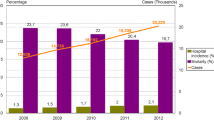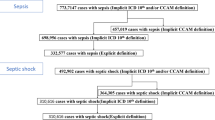Summary
Sepsis is one of the leading causes of death in intensive care units (ICUs) and has enormous relevance in health economics. There is growing evidence, however, that a significant percentage of patients with sepsis are not treated in an ICU. The aim of this study was to describe the epidemiology and short- and long-term mortality of sepsis according to patients’ location on general wards or in an ICU over a period of a year. We retrospectively collected data on patients with sepsis admitted to the General Hospital of Vienna during a 12-month period. We used world health organization (WHO) ICD-10 classification as the selection criterion and analyzed demographic data, length of stay, and 28-day, hospital, and 3-year mortality on general wards and in the ICU. A total of 68,305 inpatient admission episodes between January 1 and December 31, 2007 were screened for sepsis. Using ICD-10 codes we identified 139 patients with sepsis, giving a cumulative hospital incidence of 2 cases/1,000 admissions; 32 % of these patients needed ICU treatment. The overall 28-day mortality rate was 29.5 %, increasing to 55.4 % 3 years after hospital discharge. On general wards the 28-day mortality rate was 12.6 %, increasing to 42.1 % 3 years after discharge; the respective rates for the ICU were 65.9 and 84.1 %. Sepsis is a disease of predominantly elderly patients. The majority of sepsis occurred on general wards and about 30 % in the ICU. Considerable number of patients with sepsis on general wards died after hospital discharge, thus the often used 28-day in-hospital mortality rate may fail to capture the true impact of sepsis on subsequent outcome.
Zusammenfassung
Sepsis ist eine der häufigsten Todesursachen auf Intensivstationen und hat eine erhebliche gesundheitsökonomische Bedeutung. Zuletzt gab es jedoch vermehrt Hinweise, dass eine beträchtliche Anzahl an Patienten mit Sepsis nicht auf Intensivstationen behandelt werden. Ziel dieser Studie war es, die Epidemiologie sowie die Kurz- und Langzeitmortalität der Sepsis im Verlauf eines Jahres entsprechend der Patientenverteilung auf Normal- und Intensivstationen zu ermitteln. Die WHO ICD-10 Codierung diente als Auswahlkriterium, um retrospektiv Daten von Patienten, die innerhalb einer 12-monatigen Periode mit Sepsis im Allgemeinen Krankenhaus Wien aufgenommen wurden, zu erheben. Es wurden demographische Daten, Aufenthaltsdauer und 28-Tage-, Krankenhaus- sowie 3-Jahres-Mortalität auf Normal- und Intensivstationen analysiert. Insgesamt 65.305 stationäre Aufnahmen zwischen 1. Januar 2007 und 31. Dezember 2007 wurden nach Sepsis gescreent. Mit Hilfe der ICD-10 Codes wurden 139 Patienten mit Sepsis identifiziert. Das er-gibt eine kumulative Krankenhausinzidenz von 2 Fällen pro 1000 Aufnahmen; 32 % dieser Patienten waren intensivpflichtig. Die 28-Tage-Mortalität im Gesamt-kollektiv betrug 29,5 % und stieg 3 Jahre nach Entlassung auf 55,4 % an. Auf Normalstationen lag die 28-Tage-Mortalität bei 12,6 % und stieg 3 Jahren nach Entlassung auf 42,1 % an; die entsprechenden Raten auf Intensivstationen lagen bei 65,9 und 84,1 %. Sepsis ist in erster Linie eine Erkrankung älterer Patienten. Der überwiegende Anteil an Sepsisfällen trat auf Normalstationen auf und etwa 30 % der septischen Patienten wurden auf der Intensivstation behandelt. Eine erhebliche Anzahl der septischen Patienten auf Normalstationen verstarb nach dem Krankenhausaufenthalt. Daher scheint die oft verwendete 28-Tage-Krankenhausmortalität unge-eignet, um das tatsächliche Outcome nach Sepsis zuermitteln.




Similar content being viewed by others
References
Angus DC, Linde-Zwirble WT, Lidicker J, Clermont G, Carcillo J, Pinsky MR. Epidemiology of severe sepsis in the United States: analysis of incidence, outcome, and associated costs of care. Crit Care Med. 2001;29(7):1303–10.
Martin GS, Mannino DM, Eaton S, Moss M. The epidemiology of sepsis in the United States from 1979 through 2000. N Engl J Med. 2003;348(16):1546–54.
Brun-Buisson C, Meshaka P, Pinton P, Vallet B. EPISEPSIS: a reappraisal of the epidemiology and outcome of severe sepsis in French intensive care units. Intensive Care Med. 2004;30(4):580–8.
Vincent JL, Bihari DJ, Suter PM, Bruining HA, White J, Nicolas-Chanoin MH, et al. The prevalence of nosocomial infection in intensive care units in Europe. Results of the European Prevalence of Infection in Intensive Care (EPIC) Study. EPIC International Advisory Committee. JAMA. 1995;274(8):639–44.
Sands KE, Bates DW, Lanken PN, Graman PS, Hibberd PL, Kahn KL, et al. Epidemiology of sepsis syndrome in 8 academic medical centers. JAMA. 1997;278(3):234–40.
Esteban A, Frutos-Vivar F, Ferguson ND, Penuelas O, Lorente JA, Gordo F, et al. Sepsis incidence and outcome: contrasting the intensive care unit with the hospital ward. Crit Care Med. 2007;35(5):1284–9.
Winters BD, Eberlein M, Leung J, Needham DM, Pronovost PJ, Sevransky JE. Long-term mortality and quality of life in sepsis: a systematic review. Crit Care Med. 2010;38(5):1276–83.
Karlsson S, Ruokonen E, Varpula T, Ala-Kokko TI, Pettila V. Long-term outcome and quality-adjusted life years after severe sepsis. Crit Care Med. 2009;37(4):1268–74.
Schmid A, Schneider H, Adlof A, Smolle KH, Edelmann G, Sporn P, et al. Economic burden of illness imposed by severe sepsis in Austria. Wien Klin Wochenschr. 2002;114(15–16):697–701.
American College of Chest Physicians/Society of Critical Care Medicine Consensus Conference: definitions for sepsis and organ failure and guidelines for the use of innovative therapies in sepsis. Crit Care Med. 1992;20(6):864–74.
Angus DC, Pereira CA, Silva E. Epidemiology of severe sepsis around the world. Endocr Metab Immune Disord Drug Targets. 2006;6(2):207–12.
Rangel-Frausto MS, Pittet D, Costigan M, Hwang T, Davis CS, Wenzel RP. The natural history of the systemic inflammatory response syndrome (SIRS). A prospective study. JAMA. 1995;273(2):117–23.
Sundararajan V, Macisaac CM, Presneill JJ, Cade JF, Visvanathan K. Epidemiology of sepsis in Victoria, Australia. Crit Care Med. 2005;33(1):71–80.
Flaatten H. Epidemiology of sepsis in Norway in 1999. Crit Care. 2004;8(4):R180–4.
Brun-Buisson C, Doyon F, Carlet J, Dellamonica P, Gouin F, Lepoutre A, et al. Incidence, risk factors, and outcome of severe sepsis and septic shock in adults. A multicenter prospective study in intensive care units. French ICU Group for Severe Sepsis. JAMA. 1995;274(12):968–74.
Padkin A, Goldfrad C, Brady AR, Young D, Black N, Rowan K. Epidemiology of severe sepsis occurring in the first 24 hrs in intensive care units in England, Wales, and Northern Ireland. Crit Care Med. 2003;31(9):2332–8.
Silva E, Pedro Mde A, Sogayar AC, Mohovic T, Silva CL, Janiszewski M, et al. Brazilian Sepsis Epidemiological Study (BASES study). Crit Care. 2004;8(4):R251–60.
Wilhelms SB, Huss FR, Granath G, Sjoberg F. Assessment of incidence of severe sepsis in Sweden using different ways of abstracting International Classification of Diseases codes: difficulties with methods and interpretation of results. Crit Care Med. 2010;38(6):1442–9.
Pittet D, Rangel-Frausto S, Li N, Tarara D, Costigan M, Rempe L, et al. Systemic inflammatory response syndrome, sepsis, severe sepsis and septic shock: incidence, morbidities and outcomes in surgical ICU patients. Intensive Care Med. 1995;21(4):302–9.
Salvo I, de Cian W, Musicco M, Langer M, Piadena R, Wolfler A, et al. The Italian SEPSIS study: preliminary results on the incidence and evolution of SIRS, sepsis, severe sepsis and septic shock. Intensive Care Med. 1995;21 Suppl 2:S244–9.
Jones GR, Lowes JA. The systemic inflammatory response syndrome as a predictor of bacteraemia and outcome from sepsis. QJM. 1996;89(7):515–22.
Ghanem-Zoubi NO, Vardi M, Laor A, Weber G, Bitterman H. Assessment of disease-severity scoring systems for patients with sepsis in general internal medicine departments. Crit Care. 2011;15(2):R95.
Haraldsen P, Andersson R. Quality of life, morbidity, and mortality after surgical intensive care: a follow-up study of patients treated for abdominal sepsis in the surgical intensive care unit. Eur J Surg Suppl. 2003;(588):23–7.
Weycker D, Akhras KS, Edelsberg J, Angus DC, Oster G. Long-term mortality and medical care charges in patients with severe sepsis. Crit Care Med. 2003;31(9):2316–23.
Engel C, Brunkhorst FM, Bone HG, Brunkhorst R, Gerlach H, Grond S, et al. Epidemiology of sepsis in Germany: results from a national prospective multicenter study. Intensive Care Med. 2007;33(4):606–18.
Author information
Authors and Affiliations
Corresponding author
Rights and permissions
About this article
Cite this article
Stiermaier, T., Herkner, H., Tobudic, S. et al. Incidence and long-term outcome of sepsis on general wards and in an ICU at the General Hospital of Vienna: an observational cohort study. Wien Klin Wochenschr 125, 302–308 (2013). https://doi.org/10.1007/s00508-013-0351-1
Received:
Accepted:
Published:
Issue Date:
DOI: https://doi.org/10.1007/s00508-013-0351-1




